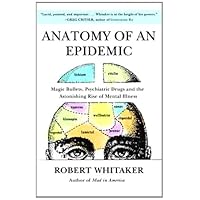
Average Reviews:

(More customer reviews)Robert Whitaker's Anatomy of an Epidemic reveals the damage that can and very often does result from long-term use of psychotropic drugs, and, along with it, the alarming rise in chronic mental illness in this country since such drugs as Thorazine were introduced in the 1950s. Because this drug could cause tardive dyskinesia and other permanent nervous system damage, the pharmaceutical industry got to work on new generations of drugs that are being used now.
The rise in drug use corresponds with psychiatry staking a renewed claim to therapeutic expertise and market share, which had begun to erode due to competition from counselors, social workers and others (see the Selling of DSM by Kirk and Kutchins -- [...]-- and Making Us Crazy by the same authors). The prescription pad, and the power of academic psychiatry in collaboration with Big Pharma, allowed psychiatry to open up a very large market, one that today seems to encompass the entire population.
Whitaker documents the alarming rise of disability and increasing number of people on SSI and SSDI due to mental illness over the last 50 years, including the increase since the 1980s, when serotonin reuptake inhibitors such as Prozac were introduced, and again, with the introduction of what are called atypical antipsychotics (e.g., Risperdal, Zyprexa), and reliance on drugs in the benzodiazepine family (Valium). But perhaps the most tragic of all cases with drugs used to treat what were once considered within the range of "normal" behavior (e.g., shyness) is the prescribing of amphetamine-like agents such as Ritalin or Adderall for so-called attention deficit disorder (ADHD) in children, and, even worse, powerful psychotropic drug cocktails to treat a newly introduced category of illness, childhood-onset bipolar disorder. In all of these cases, Whitaker documents how long-term use of such drugs can lead to severe debilitating effects and what may be irreversible brain damage. He also reveals that there is no scientific evidence, none whatsoever, for the psychiatric storyline that psychotropic drugs compensate for chemical imbalances in the brain.
Impeccably researched and documented, Whitaker's book is based on long-term outcome studies that have received almost no publicity from psychiatry and other guardians of the psychiatric establishment, including, of course, the pharmaceutical companies that keep churning out new generations of magic bullets. It's a multibillion dollar industry with a lot to lose were the full truth about the drug risks disclosed and understood.
While far from an anti-psychiatry or anti-drug polemic, Whitaker's interviews with patients who are on psychiatric medications are nonetheless heartrending. Also revealing is his disclosure of the brutal treatment meted out to maverick doctors like Peter Breggin, David Healy and Loren Mosher, who all questioned the efficacy of pharmaceutical treatment of mental disorders, from schizophrenia to bipolar disorder and other maladies. Harvard Medical School-trained Breggin was in effect blacklisted. Mosher lost his position with the NIMH over his successful drug-free treatment of patients through the Soteria project he founded. And Healy promptly lost a job offer after publicizing his criticism of SSRIs and their possible relation to suicide.
In a TLS April 2009 review of Healy's book Mania, the reviewer says Healy "goes on to describe how Big Pharma has captured almost total control over the research process, to say nothing of buying up academic experts and turning them into marketing shills." Whitaker essentially reports the same thing; especially telling is the chapter titled Tallying Up the Profits, including a subsection titled the Money Tree.
On top of this, there is the DSM, or Diagnostic and Statistical Manual (the fifth edition soon to be released; see Ofer Zur's critique at the Zur Institute site), with its ever-expanding list of disorders. No longer are only those thought to be suffering from schizophrenia or bipolar disorder entreated to take their medication, without which, they are told, they would be like a "diabetic without insulin." Now everyone suffering from problems such as grief or the blues or any number of things -- in the case of children, ADHD, "oppositional defiant disorder" or childhood-onset bipolar disorder -- are also told they should take drugs, as if they needed the psychological equivalent of insulin. The tragedy in the case of children is that often, after taking stimulant drugs, they begin to experience psychotic symptoms. Then, more drugs are used to treat the additional symptoms, a fact that accounts for more and more young people ending up on disability rolls.
I hope everyone who sees a primary care doctor or counselor or any kind of therapist will read this book and think twice or a dozen times before attempting to solve any type of emotional problem or bedeviling symptoms with Big Pharma remedies. While Whitaker does explain how such medicines can be useful in taking down severe symptoms on a short-term basis, this book sounds the alarm to proceed with caution. Once "treatment" is begun, brain chemistry is altered, and an insidious dependence on the drugs can develop. Withdrawal from the drugs also sounds as if it might be more challenging than withdrawal from heroin or cocaine.
On a positive note, Whitaker has started a blog that accompanies description of this book at his Mad in America book site. Here, he not only lists results of the long-term studies he documents, but also lists promising alternative treatments, including exercise, that are helping people. I admire Whitaker's courage in writing this book, which can give hope to all the people psychiatry may have condemned to chronic illness. Disclosure: After meeting Robert Whitaker for the first time and hearing him speak about his book last week, we are now friends on Facebook.
Click Here to see more reviews about: Anatomy of an Epidemic: Magic Bullets, Psychiatric Drugs, and the Astonishing Rise of Mental Illness in America

No comments:
Post a Comment